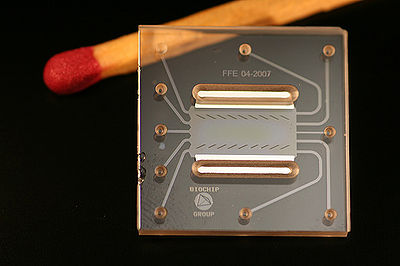m (→George Whitesides, MIT: inserted links) |
|||
| Line 3: | Line 3: | ||
Analytical devices can be produced at very low cost from simple materials. Applications are vast revolutionary, and include medical tests, environmental sensing, agriculture, soil science and many more. [http://en.wikipedia.org/wiki/Microfluidics Microfluidics] refers to a set of technologies that control the flow of minute amounts of liquids or gases—typically measured in nano- and picoliters — in a miniaturized system. With these "chips", room-sized diagnostic testing equipment can be shrunk down to the size of a postage stamp. | Analytical devices can be produced at very low cost from simple materials. Applications are vast revolutionary, and include medical tests, environmental sensing, agriculture, soil science and many more. [http://en.wikipedia.org/wiki/Microfluidics Microfluidics] refers to a set of technologies that control the flow of minute amounts of liquids or gases—typically measured in nano- and picoliters — in a miniaturized system. With these "chips", room-sized diagnostic testing equipment can be shrunk down to the size of a postage stamp. | ||
==Materials Used== | ==Materials and Equipment Used== | ||
blotter paper, regular paper, wax paper, [http://www.shrinkydinks.com/ shrinky-dink], transparency film, cotton thread, sewing needles, | consumables: blotter paper, regular paper, wax paper, [http://www.shrinkydinks.com/ shrinky-dink], transparency film, cotton thread, sewing needles, wood sticks, [http://www.physorg.com/news195910096.html Jell-O], ?beeswax?, | ||
equipment: syringes, cell phone cameras, plastic lenses for cheap microscopes, | |||
==Applications== | ==Applications== | ||
Revision as of 14:58, 12 February 2011

Analytical devices can be produced at very low cost from simple materials. Applications are vast revolutionary, and include medical tests, environmental sensing, agriculture, soil science and many more. Microfluidics refers to a set of technologies that control the flow of minute amounts of liquids or gases—typically measured in nano- and picoliters — in a miniaturized system. With these "chips", room-sized diagnostic testing equipment can be shrunk down to the size of a postage stamp.
Materials and Equipment Used
consumables: blotter paper, regular paper, wax paper, shrinky-dink, transparency film, cotton thread, sewing needles, wood sticks, Jell-O, ?beeswax?,
equipment: syringes, cell phone cameras, plastic lenses for cheap microscopes,
Applications
- medicine: immediate testing ("point-of-care"), genetic testing and research, pathogens
- agriculture: plant breeding, pests, nutrition,
- environmental sensing: water testing, air quality, toxins
- geoscience: soil science, mining
- energy: development of biofuels
George Whitesides, Harvard University
In his legendary career in chemistry, George Whitesides has been a pioneer in microfabrication and nanoscale self-assembly. Now, he's fabbing a diagnostic lab on a chip.
Further Reading
- Disposable microfluidic devices created using regular wax paper
- Shrinky Dink® microfluidics - academic paper here
- Wikipedia: Microfluidics and Lab-on-a-chip